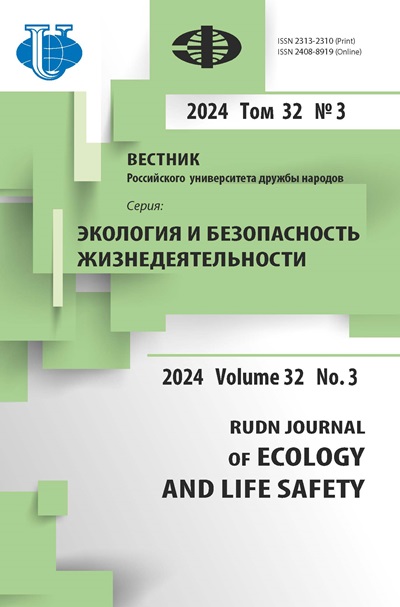Оценка эрозии почвы Бурунди с использованием дистанционного зондирования и ГИС по модели РУСЛЕ
- Авторы: Нижимбере Г.1, Риверос Лизана К.R.1
-
Учреждения:
- Кубанский государственный аграрный университет имени И.Т. Трубилина
- Выпуск: Том 27, № 1 (2019)
- Страницы: 17-28
- Раздел: Геоэкология
- URL: https://journals.rudn.ru/ecology/article/view/22106
- DOI: https://doi.org/10.22363/2313-2310-2019-27-1-17-28
Цитировать
Полный текст
Аннотация
Настоящая статья посвящена результатам исследований по водной эрозии в Бурунди - стране, не имеющей выхода к морю, в районе африканских Великих озер, где сходятся Восточная и Центральная Африка. Сельское хозяйство развито в районах, где склоны очень крутые, а некоторые факторы, например методы землепользования, ослабляют почву и приводят к водной эрозии, что влечет за собой деградацию почвы и делает ее бесплодной. Производство по этому пути становится недостаточным для быстро растущего населения. Расширение обрабатываемой земли, часто не связанное с противоэрозионными мерами, подвергает почву интенсивной эрозии. Данные обработки спутниковых снимков (Landsat 8) позволили выявить основные места, где эрозия очень сильная. Потерянная почва оценивалась по методу РУСЛЕ и с использованием четырех растровых изображений, соответствующих факторам, связанным с осадками, разрушаемостью почвы, топографией, длиной склона и растительным покровом. Полученные результаты позволяют определить районы по всей стране, где необходимо вмешательство правительства и природоохранных учреждений для ограничения процессов деградации почвы.
Ключевые слова
Об авторах
Гилберт Нижимбере
Кубанский государственный аграрный университет имени И.Т. Трубилина
Автор, ответственный за переписку.
Email: gilbertnijimbere83@gmail.com
аспирант, кафедра селекции, генетики и семеноводства, факультет агрономии и экологии
Российская Федерация, 350044, Краснодар, ул. Калинина, 13Кристиан Riveros Риверос Лизана
Кубанский государственный аграрный университет имени И.Т. Трубилина
Email: 20110337@lamolina.edu.pe
магистр, кафедра гидравлики и сельскохозяйственного водоснабжения, факультет гидромелиорации
Российская Федерация, 350044, Краснодар, ул. Калинина, 13Список литературы
- Aquastat. Burundi. Rapp. sur l’eau. 2005;29: 1–10.
- Lim KJ, Sagong M, Engel BA, Tang Z, Choi J, Kim KS. GIS-based sediment assessment tool. Catena. 2005;64(1): 61–80.
- Gvozdenovich JJ. Calculo del factor R de la USLE a traves del indice modificacdo de Fournier. 2016(June). p. 9.
- Wang B, Zheng F, Guan Y. Improved USLE-K factor prediction: A case study on water erosion areas in China. Int. Soil Water Conserv. Res., 2016;4(3): 168–176.
- Ganasri BP, Ramesh H. Assessment of soil erosion by RUSLE model using remote sensing and GIS: A case study of Nethravathi Basin. Geosci. Front. 2016; 7(6): 953–961.
- Karaburun A. Estimation of C factor for soil erosion modeling using NDVI in Buyukcekmece watershed. Ozean J. Appl. Sci. 2010;3(1): 77–85.
- Kuok KKK, Mah DYS, Chiu PC. Evaluation of C and P Factors in Universal Soil Loss Equation on Trapping Sediment: Case Study of Santubong River. J. Water Resour. Prot. 2013;5(12): 1149–1154.
- http://hikersbay.com/climate/burundi?lang=en (Accessed 1 April 2019).
- UNECN. 2013 Stratégie Nationale et Plan d’Action sur la Biodiversité 2013–2020. p. 39–45.
- Roose EJ. Quelques exemples des effets de l’erosion hydrique sur les cultures. Colloque sur la fertilité des sols tropicaux. Tananarivè 19–25.11.1967. Communication No. 113. 1967. p. 1385–1404.
- Rishirumuhirwa T. Facteurs anthropiques de l'érosion dans les régions des montagnes et hauts plateaux de la C.E.P.G.L. (Burundi – Rwanda – Zaïre). Réseau Erosion – Bulletin. 1993;(13): 53–62.
- Koffi N, Guillaume A, Vimard P, Zanou B. Maîtrise de la croissance démographique et développement en Afrique (Colloques et Séminaires). Paris: ORSTOM; 1994: 381–402.
- Laflen JM, Roose EJ. Methodologies for assessment of soil degradation due to water erosion. USA: CRC Press LLC; 1997.
- Arnoldus HMJ. Methodology used to determine the maximum average soil loss due to sheet and rill erosion in Morocco. Soils Bulletin FAO. 1980;34: 39–48.
















